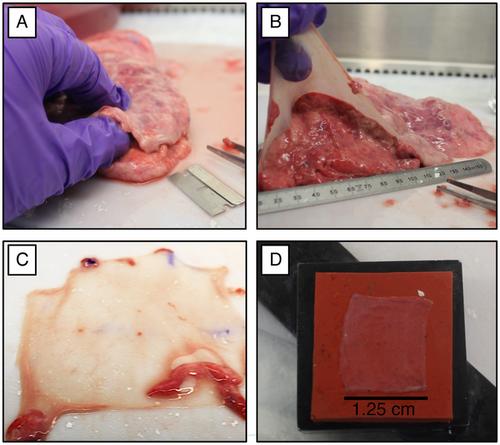{"title":"肺力学:肺部成分的材料特性分析,用于以实验为依据的计算管道。","authors":"Talyah M. Nelson, Crystal A. Mariano, Gustavo O. Ramirez, Arif Badrou, Kathrine A. M. Quiros, Matthew Shankel, Mona Eskandari","doi":"10.1002/cpz1.70001","DOIUrl":null,"url":null,"abstract":"<p>The lung comprises multiple components including the parenchyma, airways, and visceral pleura, where each constituent displays specific material properties that together govern the whole organ's properties. The structural and mechanical complexity of the lung has historically undermined its comprehensive characterization, especially compared to other biological organs, such as the heart or bones. This knowledge void is particularly remarkable when considering that pulmonary disease is one of the leading causes of morbidity and mortality across the globe. Establishing the mechanical properties of the lung is central to formulating a baseline understanding of its operation, which can facilitate investigations of diseased states and how the lung will potentially respond to clinical interventions. Here, we present established and widely accepted experimental protocols for pulmonary material quantification, specifying how to extract, prepare, and test each type of lung constituent under planar biaxial tensile loading to investigate the mechanical properties, such as physiological stress–strain profiles, anisotropy, and viscoelasticity. These methods are presented across an array of commonly studied species (murine, rat, and porcine). Additionally, we highlight how such material properties may inform the construction of an inverse finite element model, which is central to implementing predictive computational tools for accurate disease diagnostics and optimized medical treatments. These presented methodologies are aimed at supporting research advancements in the field of pulmonary biomechanics and to help inaugurate future novel studies. © 2024 The Author(s). Current Protocols published by Wiley Periodicals LLC.</p><p><b>Basic Protocol 1</b>: General procedures in lung biaxial testing</p><p><b>Alternate Protocol 1</b>: Parenchymal-specific preparation and loading procedures</p><p><b>Alternate Protocol 2</b>: Airway-specific preparation and loading procedures</p><p><b>Alternate Protocol 3</b>: Visceral pleura–specific preparation and loading procedures</p><p><b>Basic Protocol 2</b>: Computational analysis</p>","PeriodicalId":93970,"journal":{"name":"Current protocols","volume":"4 9","pages":""},"PeriodicalIF":0.0000,"publicationDate":"2024-09-06","publicationTypes":"Journal Article","fieldsOfStudy":null,"isOpenAccess":false,"openAccessPdf":"https://onlinelibrary.wiley.com/doi/epdf/10.1002/cpz1.70001","citationCount":"0","resultStr":"{\"title\":\"Lung Mechanics: Material Characterization of Pulmonary Constituents for an Experimentally Informed Computational Pipeline\",\"authors\":\"Talyah M. Nelson, Crystal A. Mariano, Gustavo O. Ramirez, Arif Badrou, Kathrine A. M. Quiros, Matthew Shankel, Mona Eskandari\",\"doi\":\"10.1002/cpz1.70001\",\"DOIUrl\":null,\"url\":null,\"abstract\":\"<p>The lung comprises multiple components including the parenchyma, airways, and visceral pleura, where each constituent displays specific material properties that together govern the whole organ's properties. The structural and mechanical complexity of the lung has historically undermined its comprehensive characterization, especially compared to other biological organs, such as the heart or bones. This knowledge void is particularly remarkable when considering that pulmonary disease is one of the leading causes of morbidity and mortality across the globe. Establishing the mechanical properties of the lung is central to formulating a baseline understanding of its operation, which can facilitate investigations of diseased states and how the lung will potentially respond to clinical interventions. Here, we present established and widely accepted experimental protocols for pulmonary material quantification, specifying how to extract, prepare, and test each type of lung constituent under planar biaxial tensile loading to investigate the mechanical properties, such as physiological stress–strain profiles, anisotropy, and viscoelasticity. These methods are presented across an array of commonly studied species (murine, rat, and porcine). Additionally, we highlight how such material properties may inform the construction of an inverse finite element model, which is central to implementing predictive computational tools for accurate disease diagnostics and optimized medical treatments. These presented methodologies are aimed at supporting research advancements in the field of pulmonary biomechanics and to help inaugurate future novel studies. © 2024 The Author(s). Current Protocols published by Wiley Periodicals LLC.</p><p><b>Basic Protocol 1</b>: General procedures in lung biaxial testing</p><p><b>Alternate Protocol 1</b>: Parenchymal-specific preparation and loading procedures</p><p><b>Alternate Protocol 2</b>: Airway-specific preparation and loading procedures</p><p><b>Alternate Protocol 3</b>: Visceral pleura–specific preparation and loading procedures</p><p><b>Basic Protocol 2</b>: Computational analysis</p>\",\"PeriodicalId\":93970,\"journal\":{\"name\":\"Current protocols\",\"volume\":\"4 9\",\"pages\":\"\"},\"PeriodicalIF\":0.0000,\"publicationDate\":\"2024-09-06\",\"publicationTypes\":\"Journal Article\",\"fieldsOfStudy\":null,\"isOpenAccess\":false,\"openAccessPdf\":\"https://onlinelibrary.wiley.com/doi/epdf/10.1002/cpz1.70001\",\"citationCount\":\"0\",\"resultStr\":null,\"platform\":\"Semanticscholar\",\"paperid\":null,\"PeriodicalName\":\"Current protocols\",\"FirstCategoryId\":\"1085\",\"ListUrlMain\":\"https://onlinelibrary.wiley.com/doi/10.1002/cpz1.70001\",\"RegionNum\":0,\"RegionCategory\":null,\"ArticlePicture\":[],\"TitleCN\":null,\"AbstractTextCN\":null,\"PMCID\":null,\"EPubDate\":\"\",\"PubModel\":\"\",\"JCR\":\"\",\"JCRName\":\"\",\"Score\":null,\"Total\":0}","platform":"Semanticscholar","paperid":null,"PeriodicalName":"Current protocols","FirstCategoryId":"1085","ListUrlMain":"https://onlinelibrary.wiley.com/doi/10.1002/cpz1.70001","RegionNum":0,"RegionCategory":null,"ArticlePicture":[],"TitleCN":null,"AbstractTextCN":null,"PMCID":null,"EPubDate":"","PubModel":"","JCR":"","JCRName":"","Score":null,"Total":0}
引用次数: 0
Lung Mechanics: Material Characterization of Pulmonary Constituents for an Experimentally Informed Computational Pipeline
The lung comprises multiple components including the parenchyma, airways, and visceral pleura, where each constituent displays specific material properties that together govern the whole organ's properties. The structural and mechanical complexity of the lung has historically undermined its comprehensive characterization, especially compared to other biological organs, such as the heart or bones. This knowledge void is particularly remarkable when considering that pulmonary disease is one of the leading causes of morbidity and mortality across the globe. Establishing the mechanical properties of the lung is central to formulating a baseline understanding of its operation, which can facilitate investigations of diseased states and how the lung will potentially respond to clinical interventions. Here, we present established and widely accepted experimental protocols for pulmonary material quantification, specifying how to extract, prepare, and test each type of lung constituent under planar biaxial tensile loading to investigate the mechanical properties, such as physiological stress–strain profiles, anisotropy, and viscoelasticity. These methods are presented across an array of commonly studied species (murine, rat, and porcine). Additionally, we highlight how such material properties may inform the construction of an inverse finite element model, which is central to implementing predictive computational tools for accurate disease diagnostics and optimized medical treatments. These presented methodologies are aimed at supporting research advancements in the field of pulmonary biomechanics and to help inaugurate future novel studies. © 2024 The Author(s). Current Protocols published by Wiley Periodicals LLC.
Basic Protocol 1: General procedures in lung biaxial testing
Alternate Protocol 1: Parenchymal-specific preparation and loading procedures
Alternate Protocol 2: Airway-specific preparation and loading procedures
Alternate Protocol 3: Visceral pleura–specific preparation and loading procedures
Basic Protocol 2: Computational analysis


